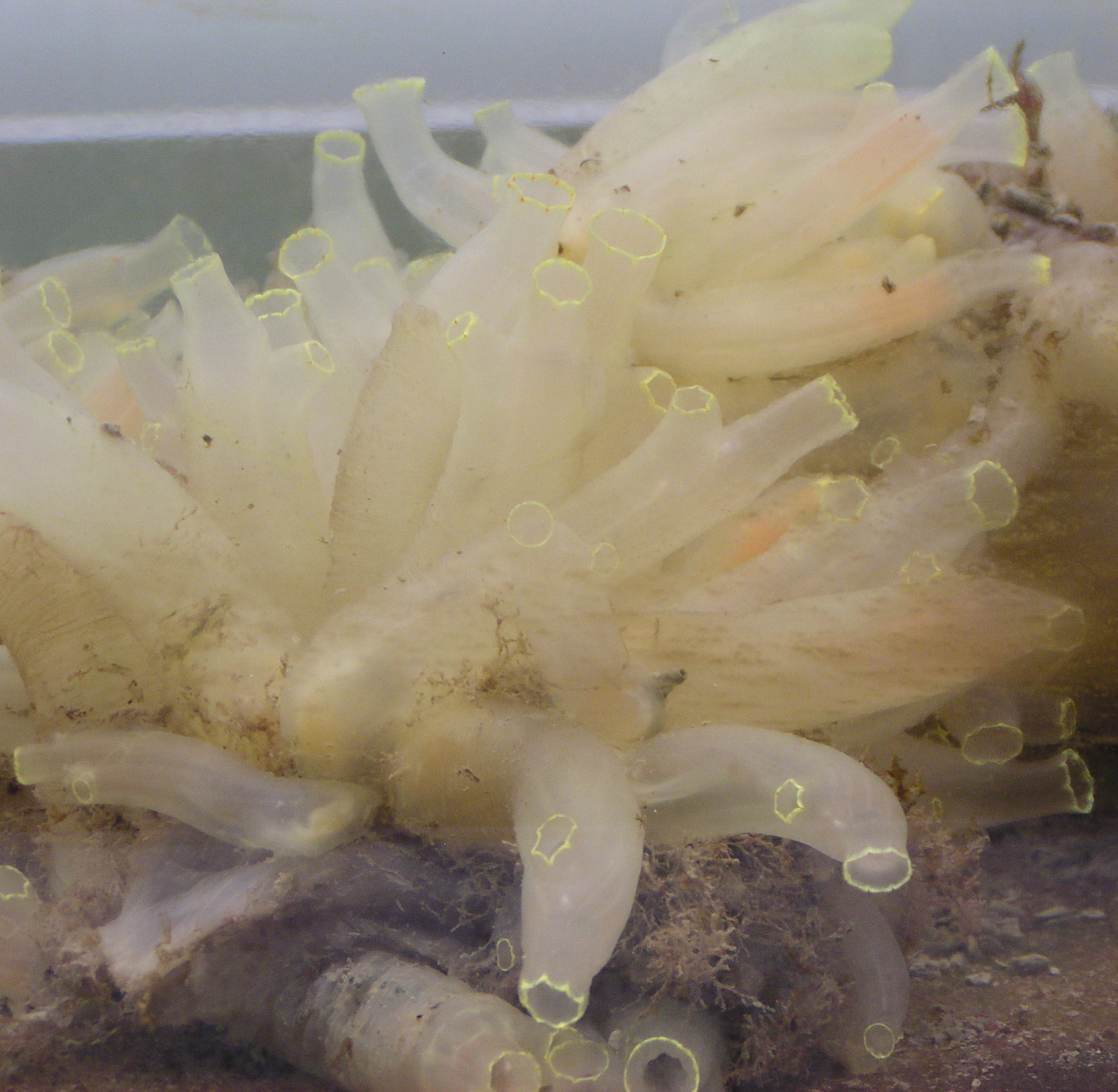Ciona intestinalis
| style="background:#Template:Taxobox colour;"|Vase tunicate | ||||||||||||||||||
|---|---|---|---|---|---|---|---|---|---|---|---|---|---|---|---|---|---|---|
 Ciona intestinalis
| ||||||||||||||||||
| style="background:#Template:Taxobox colour;" | Scientific classification | ||||||||||||||||||
| ||||||||||||||||||
| Binomial name | ||||||||||||||||||
| Ciona intestinalis (Linnaeus, 1767) |
Ciona intestinalis or vase tunicate is a Urochordata (sea squirt) whose genome has been sequenced has become, over the past decade, a major experimental model for developmental biologists.
Ciona intestinalis is a solitary tunicate with a cylindrical, gelatinous body, up to 14 cm long. The soft, smooth, translucent tunic (outer skin) is pale yellow or green in colour with orange body parts visible through the translucent tunic. Incurrent and excurrent siphons are easily seen near the tip of the organism.
The body of Ciona is bag-like and covered by a tunic, which is a secretion of the epidermal cells. The body is attached at a permanent base located at the posterior part, and the opposite bears two openings, the Buccal and Atrial siphons. The water is drawn into the ascidian through the buccal(oral)siphon and leaves the atrium through the atrial siphon(cloacal).
It is considered to be an invasive species and grows in dense aggregations on any floating or submerged substrate, particularly artificial structures like pilings, aquaculture gear, floats and boat hulls, in the lower intertidal to sub-tidal zones. Often grows with or on other fouling organisms.
Ciona intestinalis is a hermaphroditic broadcast spawner but cannot self-fertilize. Eggs and sperm, when released, can stay in the water column for 1 to 2 days while the larvae are free-swimming for 2 to 10 days.
Ciona intestinalis is thought to be spread to new areas mainly through hull fouling. Since its larvae can live for up to 10 days this species may also be transferred through the release of bilge or ballast water.
To avoid spreading this organism fish and shellfish harvesters should avoid transferring harvested shellfish and fishing gear to other areas. Gear should be thoroughly dried before transfer. Boat hulls should be inspected and, if necessary, thoroughly cleaned and disinfected with bleach or vinegar and dried before moving to other areas. Any organisms removed from boat hulls or gear should be disposed of on land. Bilge water should be released on land or disinfected.
Hox Genes
The draft genome analysis identified nine Hox genes, which are Ci-Hox1, 2, 3, 4, 5, 6, 10, 12, and 13.[1] Ciona savignyi, the closest relative of Ciona intestinalis, also have the same set of Hox genes. The organization of Hox genes is only known for C. intestinalis among asicdians. The nine Hox genes are located on two chromosomes; Ci-Hox1 to 10 on one chromosome and Ci-Hox12 and 13 on another. The intergenic distances within the Ciona Hox genes are extraordinarily long. Seven Hox genes, Ci-Hox1 to 10, are distributed, spanning approximately half the length of the chromosome. From comparisons to the Hox gene expressions and locations in other species, it is likely that the ascidian genomes are under a dispersing condition.[2]
External links
- MarLIN, detailed species review
- Ciona intestinalis genome sequencing project
- ANISEED A model organism database for Ciona intestinalis and Halocynthia roretzi
- Ghost: genomic and cDNA resources
- Four-dimensional Ascidian Body Atlas
- CIPRO Ciona intestinalis protein database
ca:Ciona intestinalis it:Ciona intestinalis sv:Tarmsjöpung
- ↑ Dehal P, Satou. et al. 2002. The draft genome of Ciona intestinalis: insights into chordate and vertebrate origins. Science 298:2157-2167 \ Spangnuolo A, et. al. 2003. Unusual number and genomic organization of Hox genes in the tunicate Ciona intestinalis. Gene 309:71-79.
- ↑ Ikuta, Tetsuro, and Hidetoshi Saiga. "Organization of Hox genes in ascidians: Present, past, and future." Developmental Dynamics 233.2 (2005): 382-89.